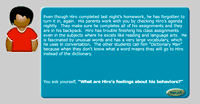Since the incidence of ADHD is much higher than other disabling conditions, it is one that will be encountered more often in our search for the “twice exceptional” student. A student could be diagnosed with ADHD when in fact he/she is gifted and reacting to an inappropriate curriculum (Webb & Latimer, 1993). The key to differentiating between the two is by looking at the frequency of the "acting out" behaviors. If the acting out is specific to certain situations, the student’s behavior is more likely related to giftedness. If the behavior is consistent across all situations, the student’s behavior is more likely related to ADHD. However, the two are not mutually exclusive. In other words, a student could be BOTH gifted and have ADHD. The following lists highlight the similarities between giftedness and ADHD.
Click on each tab for more information on each term.
- Gifted Students Who Are Bored
- Gifted Student with ADHD
- How To Tell Difference Between ADHD and Boredom
- Poor attention and daydreaming when bored
- Low tolerance for persistence on tasks that seem irrelevant
- Begin many projects, see few to completion
- Development of judgment lags behind intellectual growth
- Intensity may lead to power struggles with authorities
- High activity level; may need less sleep
- Difficulty restraining desire to talk; may be disruptive
- Question rules, customs, and traditions
- Lose work, forget homework, are disorganized
- May appear careless
- Highly sensitive to criticism
- Do not exhibit problem behaviors in all situations
- More consistent levels of performance at a fairly consistent pace
(Cline, 1999; Webb & Latimer, 1993)
- Poorly sustained attention
- Diminished persistence on tasks not having immediate consequences
- Often shift from one uncompleted activity to another
- Impulsivity, poor delay of gratification
- Impaired adherence to commands to regulate or inhibit behavior in social contexts
- More active, restless than other students
- Often talk excessively
- Often interrupt or intrude on others (e.g., butt into games)
- Difficulty adhering to rules and regulations
- Often lose things necessary for tasks or activities at home or school
- May appear inattentive to details
- Highly sensitive to criticism
- Problem behaviors exist in all settings, but in some are more severe
- Variability in task performance and time used to accomplish tasks
(Barkley, 1990; Cline, 1999; Webb & Latimer, 1993)
Asking some key questions and then testing out your theory may help solve the dilemma.
- Could the behaviors be responses to inappropriate placement, insufficient challenge, or lack of intellectual peers?
- Is the student able to concentrate when interested in the activity?
- Have any curricular modifications been made in an attempt to change inappropriate behaviors?
- Has the student been interviewed?
- What are his/her feelings about the behaviors?
- Does the student feel out of control?
- Do the parents perceive the student as being out of control?
- Do the behaviors occur at certain times of the day, during certain activities, with certain teachers or in certain environments?
Print a list of the characteristics of gifted students mentioned above.

Now let's check to see if you can tell the difference between ADHD and boredom. Click on the graphic on the left to launch this great interactive activity.
For more information on identifying ADHD and Giftedness, look at the chart, ADHD and Giftedness: The Same or Different?![]() compiled by F. Richard Olenchak from the University of Houston. This chart compares common behaviors of ADHD children to gifted children. Also in this document, he provides some questions to ask before referring an ADHD child for gifted screening and 10 steps for accommodating his or her needs. When you have finished, close the window to return to the course content.
compiled by F. Richard Olenchak from the University of Houston. This chart compares common behaviors of ADHD children to gifted children. Also in this document, he provides some questions to ask before referring an ADHD child for gifted screening and 10 steps for accommodating his or her needs. When you have finished, close the window to return to the course content.
